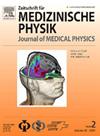Halcyon 3.0 直线加速器上不同 CBCT 方案的成像剂量 - 在人体模型中进行的 TLD 测量。
IF 4.2
4区 医学
Q2 RADIOLOGY, NUCLEAR MEDICINE & MEDICAL IMAGING
引用次数: 0
摘要
简介影像引导放射治疗通过对患者进行精确定位,可对肿瘤进行特别适形的照射。影像引导放射治疗已成为放射治疗的标准,可增加患者的成像剂量。Halcyon 3.0 直线加速器(瓦里安医疗系统公司,加利福尼亚州帕洛阿尔托)因其几何形状需要每天进行成像。因此,加速器配备了在线 kV 和 MV 成像。然而,每日照射所需的 CBCT 图像会产生额外的辐射,从而增加正常组织的剂量,因此会影响患者的继发性癌症风险。本研究测量了 kV 系统的实际器官剂量,并比较了所有可用 kV CBCT 方案的正常组织剂量,以显示不同实体和方案的成像剂量差异。此外,还评估了成像的有效剂量和二次癌症风险:使用热释光剂量计在根据各实体(脑、头颈、乳腺、肺、骨盆)定位的拟人化模型中进行测量。使用所有可用的预设方案获取 CBCT 图像,无需进一步调整参数。然后对每个位置和每个方案的测量剂量进行比较,并计算相关和特定辐射敏感器官的二次癌症风险:结果发现,使用相应的快速和低剂量模式,骨盆和头部等方案的成像剂量最多可分别减少一半。另一方面,较大的视野尺寸或大剂量模式产生的剂量高于其初始方案。研究发现,"图像平缓 "模式对正常组织的损伤最小,但由于图像质量低或投影数据不足,该模式不适用于某些实体:讨论:通过使用适当的 kV-CBCT 方案,可以在很大程度上减少成像剂量,从而保护健康组织。结合对图像质量的研究,这项研究的结果可能会调整工作流程中对日常使用方案的选择。这可以避免不必要的辐射照射,降低继发性癌症风险。本文章由计算机程序翻译,如有差异,请以英文原文为准。
Imaging doses for different CBCT protocols on the Halcyon 3.0 linear accelerator – TLD measurements in an anthropomorphic phantom
Introduction
Image guided radiotherapy allows for particularly conformal tumour irradiation through precise patient positioning. Becoming the standard for radiotherapy, this increases imaging doses to the patient. The Halcyon 3.0 linear accelerator (Varian Medical Systems, Palo Alto, CA) requires daily imaging due to its geometry. For this reason, the accelerator is equipped with on-line kV and MV imaging. However, daily CBCT images required for irradiation apply additional radiation, which increases the dose to normal tissue and therefore can affect the patient's secondary cancer risk. In this study, actual organ doses were measured for the kV system, and a comparison of normal tissue doses for all available kV CBCT protocols was presented to demonstrate differences in imaging doses across entities and protocols. In addition, effective dose and secondary cancer risk from imaging are evaluated.
Material and methods
Measurements were performed with thermoluminescent dosimeters in an anthropomorphic phantom positioned according to each entity (brain, head and neck, breast, lung, pelvis). CBCT images were obtained, using all available pre-set protocols without further adjustment of the parameters. Measured doses for each position and each protocol were then compared and secondary cancer risk of relevant and specifically radiosensitive organs was calculated.
Results
It was found that imaging doses for protocols such as Pelvis and Head could be reduced by up to half using the corresponding Fast and Low Dose modes, respectively. On the other hand, larger field sizes or the Large mode yielded higher doses than their initial protocols. Image Gently was found to spare normal tissue best, however it is not suitable for certain entities due to low image quality or insufficient projection data.
Discussion
By using appropriate kV-CBCT protocols, it is possible to reduce imaging doses to a significant extent and therefore spare healthy tissue. Combined with studies of image quality, the results of this study could lead to adjustments in workflow regarding the choice of protocols used in daily routine. This could prevent unnecessary radiation exposure and reduce secondary cancer risk.
求助全文
通过发布文献求助,成功后即可免费获取论文全文。
去求助
来源期刊
CiteScore
3.70
自引率
10.00%
发文量
69
审稿时长
65 days
期刊介绍:
Zeitschrift fur Medizinische Physik (Journal of Medical Physics) is an official organ of the German and Austrian Society of Medical Physic and the Swiss Society of Radiobiology and Medical Physics.The Journal is a platform for basic research and practical applications of physical procedures in medical diagnostics and therapy. The articles are reviewed following international standards of peer reviewing.
Focuses of the articles are:
-Biophysical methods in radiation therapy and nuclear medicine
-Dosimetry and radiation protection
-Radiological diagnostics and quality assurance
-Modern imaging techniques, such as computed tomography, magnetic resonance imaging, positron emission tomography
-Ultrasonography diagnostics, application of laser and UV rays
-Electronic processing of biosignals
-Artificial intelligence and machine learning in medical physics
In the Journal, the latest scientific insights find their expression in the form of original articles, reviews, technical communications, and information for the clinical practice.

 求助内容:
求助内容: 应助结果提醒方式:
应助结果提醒方式:


